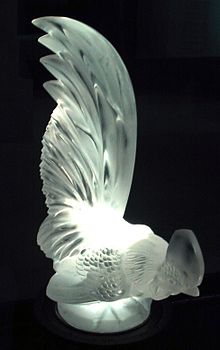René Lalique: Difference between revisions
Patagoniaddd (talk | contribs) Reverted edit 431279895 spam external link by Nilstevens (talk) |
Nilstevens (talk | contribs) |
||
| Line 37: | Line 37: | ||
*[http://www.cristallalique.fr/v1/index.htm Lalique company, with a biography of the artist] from the company web site. |
*[http://www.cristallalique.fr/v1/index.htm Lalique company, with a biography of the artist] from the company web site. |
||
*[http://www.museu.gulbenkian.pt/nucleos.asp?nuc=a11&lang=en Lalique jewels] in the [[Museu Calouste Gulbenkian]] |
*[http://www.museu.gulbenkian.pt/nucleos.asp?nuc=a11&lang=en Lalique jewels] in the [[Museu Calouste Gulbenkian]] |
||
*[http://www.djllalique.com DJL Lalique]Rene Lalique artistry and Glass Artworks. |
|||
* {{cite web |publisher= [[Victoria and Albert Museum]] |
* {{cite web |publisher= [[Victoria and Albert Museum]] |
||
|url= http://www.vam.ac.uk/vastatic/microsites/1157_art_deco/about/starobjects/vase.htm |
|url= http://www.vam.ac.uk/vastatic/microsites/1157_art_deco/about/starobjects/vase.htm |
||
Revision as of 05:42, 7 June 2011
This article needs additional citations for verification. (December 2007) |

René Jules Lalique was a renowned glass designer. He became known for his stunning creations of perfume bottles, vases, jewellery, chandeliers, clocks and in the later part of René's life, automobile hood ornaments. He was born in Ay, a small French village on 6 April 1860 and lived until 5 May 1945. He started a glassware firm, named after himself, which still remains successful.
Life and education
René Jules Lalique's early life was spent learning the methods of design and art he would use in his later life. At the age of two his family moved to a suburb of Paris due to his father's work, but traveled to Ay for summer holidays. These trips to Ay influenced Lalique's later naturalistic glasswork. In 1872, when he was twelve, he entered the College Turgot where he started drawing and sketching. With the death of his father two years later, Lalique began working as an apprentice to the goldsmith Louis Aucoc in Paris, and attended evening classes at the Ecole des arts décoratifs. He worked there for two years and then in 1876 moved to London to attend the Sydenham Art College for two years.
Art Nouveau jewelry designer


At the Sydenham Art College, his skills for graphic design were improved, and his naturalistic approach to art was further developed. When he returned from England, he worked as a freelance artist, designing pieces of jewellery for French jewelers, Cartier, Boucheron and others. In 1885 he opened his own business and designed and made his own jewellery and other glass pieces. By 1890, Lalique was recognized as one of France's foremost Art Nouveau jewellery designers; creating innovative pieces for Samuel Bing's new Paris shop, Maison de l'Art Nouveau. He went on to be one of the most famous in his field, his name synonymous with creativity, beauty and quality.
Glass maker

In the 1920s he also became famous for his work in the Art Deco style. He was also responsible for the walls of lighted glass and elegant coloured glass columns which filled the dining room and "grand salon" of the SS Normandie and the interior fittings, cross, screens, reredos, font of St. Matthew's Church at Millbrook in Jersey [1] (Lalique's Glass Church). His earlier experiences in Ay were his defining influence later his work. As a result, many of his jewelry pieces and vases showcase plants, flowers and flowing lines.
On May 5, 1945 René Lalique was buried in Père Lachaise Cemetery in Paris, France. His granddaughter, Marie Claude-Lalique (b. 1936), was also a glass maker. She died on April 14, 2003 in Fort Myers, Florida.
Recognized as one of the world's greatest glass makers and jewelry designers of the Art Nouveau and Art Deco periods, René Jules Lalique was an imaginative and creative artist, designer, and industrialist in all his work. It was said of him 'his work frankly bears the mark of our complicated civilisation, a thirst for elegance, novelty, comfort and luxury.[2]
References
Bibliography
- William Warmus;The Essential Rene Lalique .Harry N Abrams Inc New York, 2002 ISBN 978-0810958364
- Bayer,Patricia & Waller,Mark: The Art of Rene Lalique ,Bloomsbury Publishing Ltd, London 1988 ISBN 0-7475-0182-3
- Dawes,Nicholas M: Lalique Glass,Crown Publishers ,London 1986 ISBN 978-0517558355
External links
- Rene Lalique Biography at RLalique.com.
- Lalique company, with a biography of the artist from the company web site.
- Lalique jewels in the Museu Calouste Gulbenkian
- DJL LaliqueRene Lalique artistry and Glass Artworks.
- "René Lalique -'Oranges' vase". Victoria and Albert Museum. Retrieved 2007-11-15.
- This is Jersey article on St Matthew's Millbrook, the "Glass Church".
- René Lalique at Find a Grave
- Musée Lalique official website of the only European museum entirely about Lalique
